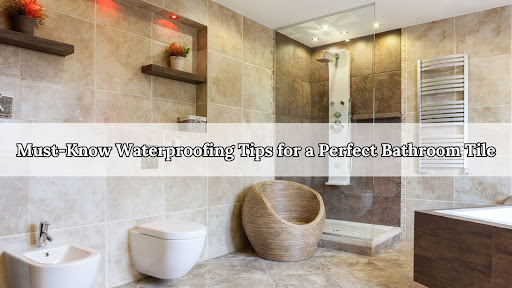Are you tired of dealing with water damage and mold in your bathroom? Do you worry about the longevity of your bathroom tiles? Waterproofing is the solution!
Ensuring your bathroom tiles are properly waterproofed can save you from costly repairs, health hazards, and aesthetic issues. In this article, we’ll dive into essential waterproofing tips that address your concerns and help you achieve a perfect bathroom tile installation.
Why Waterproofing is Essential for Bathroom Tiles
- Preventing Water Damage
Waterproofing your modern bathroom floor tile helps prevent water from seeping through the grout and damaging the underlying structures. Water damage can lead to costly repairs and compromise the integrity of your bathroom.
- Avoiding Mold and Mildew
Moist environments like bathrooms are breeding grounds for mold and mildew. Proper waterproofing keeps moisture at bay, reducing the risk of mold growth, which can cause health issues and unpleasant odors.
- Enhancing Durability
Well-waterproofed tiles last longer and maintain their aesthetic appeal. Waterproofing helps in preventing cracks, discoloration, and other forms of tile deterioration.
Pre-Installation Waterproofing Tips
Choose the Right Waterproof Membrane
The first step in waterproofing is selecting the right membrane. Two main types exist: liquid membranes and sheet membranes.
- Liquid Waterproof Membranes: Applied with a brush or roller, liquid membranes form a seamless waterproof barrier when dry. They are flexible and ideal for covering uneven surfaces.
- Sheet Waterproof Membranes: Sheet membranes are pre-fabricated sheets that are applied to the surface. They are durable and provide consistent thickness, making them ideal for high-moisture areas.
Preparing the Surface
Proper surface preparation is crucial for effective waterproofing. First, thoroughly clean the surface to remove dust, dirt, grease, and contaminants using a suitable cleaner and rinsing well.
Ensure the surface is completely dry by using fans or allowing ample drying time to eliminate residual moisture, which is vital for proper membrane adhesion. Inspect and repair cracks or holes with a suitable filler or patching compound, then smooth out the repaired areas with a trowel or sandpaper to create an even surface.
Finally, ensure the entire surface is smooth and even use a trowel or sanding block to eliminate bumps or ridges.
Priming the Surface
Priming the surface enhances the adhesion of the waterproof membrane. Select a primer compatible with your waterproof membrane, ideally from the same manufacturer for optimal bonding.
Apply the primer evenly with a brush, roller, or sprayer, adhering to the manufacturer’s instructions for the correct amount and method. Ensure thorough coverage, paying special attention to corners, joints, and edges, using a brush for tight areas to prevent water intrusion.
Allow the primer to dry completely, following the recommended drying time to ensure proper adhesion. Inspect the primed surface for even application and adhesion, reapplying primer to any missed spots or thin areas.
Proper preparation and priming ensure a reliable and long-lasting waterproofing system, preventing water damage and maintaining the integrity of your bathroom tiles.
Post-Installation Waterproofing Tips
- Grouting and Sealing: Once the tiles are installed, the next step is grouting. Use waterproof grout to fill the gaps between tiles. After the grout has dried, apply a grout sealer to enhance its waterproofing properties.
- Regular Maintenance: Regular maintenance is key to ensuring the longevity of your waterproofing. Check for any cracks or gaps in the grout and reapply sealant as needed. Clean the tiles regularly to prevent mold and mildew growth.
- Inspecting for Leaks: Periodically inspect your bathroom for signs of leaks or water damage. Early detection can prevent major issues and extend the life of your tiles.
Advanced Waterproofing Techniques
- Using Waterproof Backer Boards: For areas that are prone to heavy water exposure, consider using waterproof backer boards. These boards provide an additional layer of protection and are especially useful in showers and wet rooms.
- Installing a Vapor Barrier: In areas with high humidity, installing a vapor barrier can help prevent moisture from penetrating the walls. Vapor barriers are typically installed behind the backer board and provide an extra layer of defense against water damage.
- Drainage Systems: Proper drainage is essential for preventing water accumulation. Ensure that your bathroom has an efficient drainage system to quickly remove water. This includes sloping the floor towards the drain and installing proper drainage channels.
Installation Waterproofing Tips
Applying Waterproof Membrane
When applying the waterproof membrane, follow the manufacturer’s instructions for the best results.
| Feature | Liquid Membrane | Sheet Membrane |
| Application | Applied with a brush or roller | Applied as pre-fabricated sheets |
| Coverage | Seamless and flexible | Consistent thickness |
| Surface Compatibility | Suitable for uneven surfaces | Best for flat surfaces |
| Installation Time | Requires drying time between coats | Faster installation |
| Durability | Moderate | High |
| Ideal Use | Irregular shapes and contours | Large, flat areas |
Sealing Joints and Corners
Joints and corners are critical areas that need extra attention. Use specialized sealing tape or additional layers of membrane to reinforce these areas. Ensure that all seams are sealed to prevent water ingress.
Waterproofing Around Fixtures
Bathroom fixtures such as faucets, showerheads, and drains are potential weak points for water leaks. Apply additional waterproofing around these areas, ensuring a tight seal.
Common Waterproofing Mistakes to Avoid
- Skipping the Primer: Skipping primer causes poor adhesion, reducing membrane effectiveness. Primer bonds membrane to surface. Without it, the membrane peels or blisters, leading to leaks. Always prime before applying the membrane.
- Inadequate Coverage: Apply enough waterproof membrane to avoid weak spots. Follow the manufacturer’s guidelines for thickness and coats to prevent water damage.
- Ignoring Joints and Corners: Joints and corners leak easily if not sealed. They need extra attention and specialized tape or membrane to stay waterproof.
- Not Using Waterproof Grout: Regular grout absorbs moisture, causing mold and mildew. This leads to aesthetic issues and health problems. Use waterproof grout for bathroom tiles to keep the environment dry and hygienic. Seal the grout after it cures for extra protection.
- Overlooking Proper Surface Preparation: Clean and prepare the surface before waterproofing. Remove dust, debris, and old adhesives. Fix cracks and holes. This helps the waterproofing system work better.
- Using Incompatible Products: Use waterproofing products from the same manufacturer or ones that work well together. Incompatible products can cause poor adhesion, chemical reactions, or reduced effectiveness.
- Neglecting to Allow Proper Curing Time: Let each layer of the waterproofing system fully cure before moving on. Rushing can weaken the barrier. Follow the manufacturer’s curing time recommendations.
By avoiding these common mistakes, you can ensure that your bathroom waterproofing is effective and long-lasting, providing peace of mind and protecting your home from water damage and mold growth.
Conclusion
Waterproofing is a critical step in ensuring the durability and functionality of your bathroom tiles. By following the tips provided, you can effectively prevent water damage and mold growth, saving you from costly repairs and maintaining a healthy bathroom environment.
Regular maintenance and proper installation are key to long-lasting waterproofing. Invest time and effort into waterproofing, and you’ll enjoy a beautiful, durable bathroom for years to come.
Frequently Asked Questions
1. Why is waterproofing essential for bathroom tiles?
Waterproofing is crucial because it prevents water from seeping through the tiles and damaging the underlying structures, which can lead to costly repairs and mold growth.
2. What are the best types of waterproof membranes for bathrooms?
The best types are liquid waterproof membranes, which provide a seamless barrier, and sheet membranes, known for their durability and consistent thickness.
3. How do I prepare the surface before waterproofing?
Ensure the surface is clean, dry, and free of debris. Fill any cracks or holes and apply a primer for better adhesion of the waterproof membrane.
4. How often should I inspect my bathroom for leaks or water damage?
It’s advisable to inspect your bathroom every few months for any signs of leaks or water damage to address issues early and maintain the waterproofing.
5. Can I use regular grout for bathroom tiles?
No, it’s best to use waterproof grout, as regular grout can absorb moisture, leading to mold and mildew growth.


